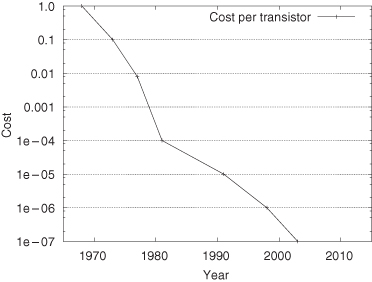1
Introduction to the Systems Approach
1.1 SYSTEM ARCHITECTURE: AN OVERVIEW
The past 40 years have seen amazing advances in silicon technology and resulting increases in transistor density and performance. In 1966, Fairchild Semiconductor [84] introduced a quad two input NAND gate with about 10 transistors on a die. In 2008, the Intel quad-core Itanium processor has 2 billion transistors [226]. Figures 1.1 and 1.2 show the unrelenting advance in improving transistor density and the corresponding decrease in device cost.
Figure 1.1 The increasing transistor density on a silicon die.

Figure 1.2 The decrease of transistor cost over the years.

The aim of this book is to present an approach for computer system design that exploits this enormous transistor density. In part, this is a direct extension of studies in computer architecture and design. However, it is also a study of system architecture and design.
About 50 years ago, a seminal text, Systems Engineering—An Introduction to the Design of Large-Scale Systems [111], appeared. As the authors, H.H. Goode and R.E. Machol, pointed out, the system’s view of engineering was created by a need to deal with complexity. As then, our ability to deal with complex design problems is greatly enhanced by computer-based tools.
A system-on-chip (SOC) ...

